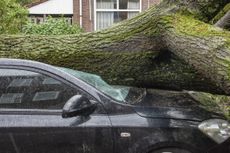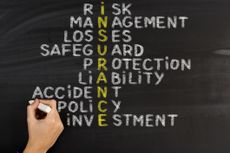Six Surprising Things Home Insurance Doesn't Cover
What does home insurance not cover? It protects you from a lot, but not from damage caused by floods, earthquakes, sinkholes, water leaks and a number of other dangers.

Fires, hurricanes, snowstorms, theft — unfortunately, there’s no shortage of bad things that can happen to your home and its contents. The good news is you can help protect your investment by getting home insurance.
But, like other types of insurance, not all home insurance policies are created equal. And many home insurance plans contain gaps, where you’re not covered for certain events. It's fairly common for individuals to assume their home insurance policy provides coverage that, in fact, it does not. For instance, many homeowners don't know that flood damage isn't covered by a typical home insurance policy. In 2022, only 4% percent of homeowners nationwide had an additional flood insurance policy.
Here, we explain what is and, notably, isn’t typically covered by home insurance.

Sign up for Kiplinger’s Free E-Newsletters
Profit and prosper with the best of expert advice on investing, taxes, retirement, personal finance and more - straight to your e-mail.
Profit and prosper with the best of expert advice - straight to your e-mail.
What does home insurance cover?
A basic home insurance policy pays to repair — and, in some cases, completely rebuild — your home and other structures on your property when damaged from certain events.
Most home insurance policies provide five types of coverage:
- Dwelling. This covers damage to your house and to structures attached to your home, such as a porch or garage.
- Other structures. This pays for damage to fences, sheds, freestanding garages, and other structures that are not attached to your house but are located on the property.
- Personal property. This reimburses you for your possessions, including furniture, electronics, appliances or clothing, if they’re damaged or lost in a covered event.
- Loss of use. This pays for your temporary living expenses, such as hotel bills or meals, while your home is being repaired after a disaster.
- Personal liability. This covers the costs of medical bills for people who get hurt on your property and your legal fees if the person sues you for damages.
Does home insurance cover damage from natural disaster?
Most policies cover damage to your home from natural disasters, such as tornados, hurricanes, lightning, snowstorms and fires. They also cover damage to detached structures located on your property, such as a shed, garage, fence or gazebo.
Does home insurance cover what's in your home?
Home insurance policies also cover the contents of your home from damage or theft. But keep in mind, you may need to provide evidence of your belongings to your insurance provider when you file a claim. (Pro tip: Take pictures of your possessions and store them on the cloud so that you’re prepared).
Does home insurance cover short-term living expenses?
Temporary living expenses, during loss of use, are covered under a typical home insurance policy as well. This coverage pays for short-term living expenses, such as hotel bills, meals and other expenses listed in your policy, while your home is being rebuilt after a disaster — though some policies place time limitations or reimbursement limits on temporary living expenses.
Does home insurance protect you against lawsuits for injury or property damage?
Standard home insurance provides liability protection against lawsuits for bodily injury or property damage that you or your family members cause to other people when they’re on your property. This protection pays for attorney fees and any court awards up to your policy’s limit.
What does home insurance not cover?
There are a number of potential damages or liabilities that a standard home insurance policy does not protect you from. Here are some of the most common ones.
1. Does home insurance protect you from a flood?
A standard home insurance policy does not cover damage to your dwelling or detached structures from a flood. If your home is located in a flood zone, your mortgage lender will likely require you to purchase flood insurance from the federal government’s National Flood Insurance Program or from a private insurer.
Flood insurance typically costs an average of about $888 per year, according to a Policy Genius report, but premiums can vary depending on your property's elevation and other flood risk factors. You can get price quotes at FloodSmart.gov.
2. Does home insurance cover earthquakes, landslides or sinkholes?
Home insurance does not cover damage that results from land movements, such as an earthquake, landslide or sinkhole.
For those who live in areas where earthquakes are a real risk, additional insurance is optimal. That's particularly true for people who live in California, Washington and Missouri, the top three earthquake markets in the country, as identified by the Federal Emergency Management Agency (FEMA).
Californians can purchase a policy through the California Earthquake Authority.
It is also possible to purchase an additional policy or add coverage for landslides or sinkholes if you are at risk.
3. Does home insurance cover water leaks?
Home insurance covers damage resulting from water leaks when the leak is sudden or accidental, such as if a pipe were to burst. But insurance does not cover damage from leaks that are a result of poor maintenance on the part of the homeowner; for example, if a homeowner fails to remedy a slow leak that causes damage over time.
4. Does home insurance cover mold?
Mold is not usually covered by a home insurance policy unless it has sprung up as a result of what's called a "covered peril," such as a water heater bursting and causing flooding, which eventually leads to mold.
Mold is not covered if it was caused by neglect, such as, say, you failing to deal with a pipe leaking water under the kitchen sink for months, which results in mold growth.
5. Does home insurance cover expensive jewelry and collectibles?
Valuable possessions such as jewelry, art, and collectibles are not covered under a standard home insurance plan. To insure these items for their full value, you’ll need to have them professionally appraised and purchase a personal property endorsement or floater to your insurance policy.
Rates can vary between providers, but you can expect to pay about 1% to 2% of your item’s value, according to Geico. For example, a $5,000 engagement ring could cost as little as $50 annually to insure.
6. Does home insurance cover home office equipment?
Run a business out of your home? A typical home insurance policy provides only $2,500 coverage for business equipment, the Insurance Information Institute reports, but for as little as $20 a year, you could be able to double your policy's coverage from $2,500 to $5,000.
You can use our tool below, powered by Bankrate, to compare home insurance rates today.
Related Content
Get Kiplinger Today newsletter — free
Profit and prosper with the best of Kiplinger's advice on investing, taxes, retirement, personal finance and much more. Delivered daily. Enter your email in the box and click Sign Me Up.

Daniel Bortz is a freelance writer based in Arlington, Va. His work has been published by The New York Times, The Washington Post, Consumer Reports, Newsweek, and Money magazine, among others.
- Alexandra TwinSenior Retirement Editor, Kiplinger.com
-
 Stock Market Today: S&P 500 Flirts With 6K as Post-Election Rally Ebbs
Stock Market Today: S&P 500 Flirts With 6K as Post-Election Rally EbbsThe S&P 500 closed just below the 6,000 mark on Monday.
By David Dittman Published
-
 Voters Approve New Veteran Property Tax Relief
Voters Approve New Veteran Property Tax ReliefTax Relief Thanks to the election, some Veterans will soon see expanded property tax exemptions.
By Kate Schubel Last updated
-
 Why I'm Keeping My Amex Gold Card Even With a Higher Annual Fee
Why I'm Keeping My Amex Gold Card Even With a Higher Annual FeeAmerican Express increased its Gold Card fee, starting October 1, but new perks are here, too. Here's the value one editor sees in the card.
By Alexandra Svokos Last updated
-
 Kiplinger Readers' Choice Awards 2024: Auto Insurance Companies
Kiplinger Readers' Choice Awards 2024: Auto Insurance CompaniesKiplinger Readers' Choice Awards The results of the Kiplinger Readers’ Choice Awards' best auto insurance company category. Our awards celebrate the very best products and services in personal finance.
By Emma Patch Published
-
 How Does a Car Insurance Deductible Work?
How Does a Car Insurance Deductible Work?Choosing the right car insurance deductible can save you real money. Know your options before you sign a policy.
By Karon Warren Last updated
-
 What Is Comprehensive Auto Insurance and What Does It Cover?
What Is Comprehensive Auto Insurance and What Does It Cover?insurance This grab bag of coverages can protect you and your vehicle from theft, fire and forces of nature.
By Donna LeValley Last updated
-
 Tips For Open Enrollment 2023
Tips For Open Enrollment 2023Open enrollment will soon be underway, and many employers are shielding workers from hefty increases in health insurance premiums. But it pays to review your options carefully.
By Kimberly Lankford Published
-
 How to Figure Out How Much Life Insurance You Need
How to Figure Out How Much Life Insurance You Needinsurance Instead of relying on rules of thumb, you’re better off taking a systematic approach to figuring your life insurance needs.
By Kimberly Lankford Last updated
-
 What Is Liability Insurance and What Does It Cover?
What Is Liability Insurance and What Does It Cover?insurance Liability insurance protects you if you injure someone else or damage their property with your car.
By Donna LeValley Last updated
-
 Want to Feel Better About Life Insurance? Go Digital
Want to Feel Better About Life Insurance? Go DigitalCustomer satisfaction with life insurance and annuity products picks up substantially when participants go digital, J.D. Power survey shows.
By Kathryn Pomroy Published